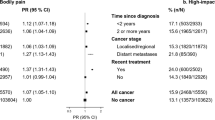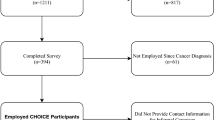Abstract
Purpose
This study estimated the prevalence of cancer-related pain in working-age cancer survivors (age 25–64 years) and evaluated differences in demographic and clinical variables in those with and without pain. We also investigated the impact of cancer-related pain on health-related quality of life (HRQoL) and employment outcomes in this population.
Methods
We used cross-sectional data from the 2016 Behavioral Risk Factor Surveillance System (BRFSS). Analyses were conducted with a sample of 1702 cancer survivors who completed treatment. All analyses were conducted using procedures to account for the complex sampling design of the BRFSS.
Results
Nearly 17% (95% CI [13.94–19.58]) of working-age cancer survivors reported experiencing cancer-related pain. Among those who experienced pain, the majority were female, white, non-Hispanic, married/partnered, and non-employed, with breast as the most common cancer disease site. Those with cancer-related pain experienced more physically unhealthy days (adjusted rate ratio [aRR] 1.63, 95% CI [1.16–2.28]), mentally unhealthy days (aRR 1.52, 95% CI [1.02–2.26]), and activity interference (aRR 2.15, 95% CI [1.53–3.02]). Cancer-related pain decreased the odds of being employed, but only in female survivors (adjusted odds ratio 0.34, 95% CI [0.22–0.54]).
Conclusion
Cancer-related chronic pain is a prevalent, long-term condition that is negatively associated with HRQoL and employment in working-age cancer survivors.
Implications for Cancer Survivors
Clinical interventions targeting chronic pain may improve HRQoL in working-age cancer survivors and employment outcomes, particularly in women.
Similar content being viewed by others
References
Siegel RL, Miller KD, Jemal A. Cancer statistics 2019. CA Cancer J Clin. 2019;69(1):7–34.
Kline RM, Arora NK, Bradley CJ, Brauer ER, Graves DL, Lunsford NB, et al. Long-term survivorship care after cancer treatment-summary of a 2017 National Cancer Policy Forum Workshop. J Natl Cancer Inst. 2018;110(12):1300–10.
Wu H-S, Harden JK. Symptom burden and quality of life in survivorship: a review of the literature. Cancer Nurs. 2015;38(1):E29–54.
Van Den Beuken-Van MH, et al. Update on prevalence of pain in patients with cancer: systematic review and meta-analysis. J Pain Symptom Manage. 2016;51(6):1070–1090. e9.
Sun Y, Shigaki CL, Armer JM. Return to work among breast cancer survivors: a literature review. Support Care Cancer. 2017;25(3):709–18.
Duijts SF, van Egmond M, Spelten E, van Muijen P, Anema JR, van der Beek A. Physical and psychosocial problems in cancer survivors beyond return to work: a systematic review. Psychooncology. 2014;23(5):481–92.
Tevaarwerk A, Lee JW, Sesto ME, Buhr KA, Cleeland CS, Manola J, et al. Employment outcomes among survivors of common cancers: the Symptom Outcomes and Practice Patterns (SOAPP) study. J Cancer Surviv. 2013;7(2):191–202.
Macdonald L, Bruce J, Scott NW, Smith WC, Chambers WA. Long-term follow-up of breast cancer survivors with post-mastectomy pain syndrome. Br J Cancer. 2005;92(2):225–30.
Lundstedt D, et al. Risk factors of developing long-lasting breast pain after breast cancer radiotherapy. Int J Radiat Oncol Biol Phys. 2012;83(1):71–8.
Bredal IS, et al. Chronic pain in breast cancer survivors: comparison of psychosocial, surgical, and medical characteristics between survivors with and without pain. J Pain Symptom Manag. 2014;48(5):852–62.
Champion VL, Wagner LI, Monahan PO, Daggy J, Smith L, Cohee A, et al. Comparison of younger and older breast cancer survivors and age-matched controls on specific and overall quality of life domains. Cancer. 2014;120(15):2237–46.
Kroenke K, Theobald D, Wu J, Loza JK, Carpenter JS, Tu W. The association of depression and pain with health-related quality of life, disability, and health care use in cancer patients. J Pain Symptom Manag. 2010;40(3):327–41.
Green CR, Hart-Johnson T, Loeffler DR. Cancer-related chronic pain: examining quality of life in diverse cancer survivors. Cancer. 2011;117(9):1994–2003.
Yabroff KR, et al. Financial hardship associated with cancer in the United States: findings from a population-based sample of adult cancer survivors. J Clin Oncol. 2016;34(3):259.
Banegas MP, Guy GP Jr, de Moor JS, Ekwueme DU, Virgo KS, Kent EE, et al. For working-age cancer survivors, medical debt and bankruptcy create financial hardships. Health Aff. 2016;35(1):54–61.
Cox-Martin E, Trahan LH, Cox MG, Dougherty PM, Lai EA, Novy DM. Disease burden and pain in obese cancer patients with chemotherapy-induced peripheral neuropathy. Support Care Cancer. 2017;25(6):1873–9.
Miller KD, Siegel RL, Lin CC, Mariotto AB, Kramer JL, Rowland JH, et al. Cancer treatment and survivorship statistics, 2016. CA Cancer J Clin. 2016;66(4):271–89.
Waldenström A-C, et al. Pain and mean absorbed dose to the pubic bone after radiotherapy among gynecological cancer survivors. Int J Radiat Oncol Biol Phys. 2011;80(4):1171–80.
Mao JJ, Armstrong K, Bowman MA, Xie SX, Kadakia R, Farrar JT. Symptom burden among cancer survivors: impact of age and comorbidity. J Am Board Fam Med. 2007;20(5):434–43.
Casadaban L, Rauscher G, Aklilu M, Villenes D, Freels S, Maker AV. Adjuvant chemotherapy is associated with improved survival in patients with stage II colon cancer. Cancer. 2016;122(21):3277–87.
Kiderlen M, Ponti A, Tomatis M, Boelens PG, Bastiaannet E, Wilson R, et al. Variations in compliance to quality indicators by age for 41,871 breast cancer patients across Europe: a European Society of Breast Cancer Specialists database analysis. Eur J Cancer. 2015;51(10):1221–30.
Leach CR, Troeschel AN, Wiatrek D, Stanton AL, Diefenbach M, Stein KD, et al. Preparedness and cancer-related symptom management among cancer survivors in the first year post-treatment. Ann Behav Med. 2017;51(4):587–98.
Peuckmann V, et al. Chronic pain and other sequelae in long-term breast cancer survivors: nationwide survey in Denmark. Eur J Pain. 2009;13(5):478–85.
Paice JA, Portenoy R, Lacchetti C, Campbell T, Cheville A, Citron M, et al. Management of chronic pain in survivors of adult cancers: American Society of Clinical Oncology clinical practice guideline. J Clin Oncol. 2016;34(27):3325–45.
Eckhoff L, et al. Persistence of docetaxel-induced neuropathy and impact on quality of life among breast cancer survivors. Eur J Pain. 2015;51(3):292–300.
Huang I-C, et al. Differential impact of symptom prevalence and chronic conditions on quality of life in cancer survivors and non-cancer individuals: a population study. Cancer Epidemiol Biomark Prev. 2017;26(7):1124–32.
Manfuku M, et al. Comparison of central sensitization-related symptoms and health-related quality of life between breast cancer survivors with and without chronic pain and healthy controls. Breast Cancer. 2019:1–8.
Hamood R, et al. Chronic pain and other symptoms among breast cancer survivors: prevalence, predictors, and effects on quality of life. Breast Can Res Treat. 2018;167(1):157–69.
Jansen L, Koch L, Brenner H, Arndt V. Quality of life among long-term (⩾ 5 years) colorectal cancer survivors–systematic review. Eur J Cancer. 2010;46(16):2879–88.
Arndt V, Koch-Gallenkamp L, Jansen L, Bertram H, Eberle A, Holleczek B, et al. Quality of life in long-term and very long-term cancer survivors versus population controls in Germany. Acta Oncol. 2017;56(2):190–7.
Beesley VL, Vallance JK, Mihala G, Lynch BM, Gordon LG. Association between change in employment participation and quality of life in middle-aged colorectal cancer survivors compared with general population controls. Psychooncology. 2017;26(9):1354–60.
Pickens CM, et al. Surveillance for certain health behaviors and conditions among states and selected local areas—behavioral risk factor surveillance system, United States, 2015. MMWR Surveill Summ. 2018;67(9):1.
Center for Disease Control and Prevention. Behavioral Risk Factor Surveillance System- Overview BRFSS 2016. https://www.cdc.gov/brfss/annual_data/2016/pdf/overview_2016.pdf. Accessed 16 Sept 2019.
Moriarty DG, Zack MM, Kobau R. The Centers for Disease Control and Prevention’s Healthy Days Measures–population tracking of perceived physical and mental health over time. Health Qual Life Outcomes. 2003;1(1):37.
Gordon LG, et al. Reduced employment and financial hardship among middle-aged individuals with colorectal cancer. Eur J Cancer Care. 2017;26(5):e12744.
Glasgow RE, Kwan BM, Matlock DD. Realizing the full potential of precision health: the need to include patient-reported health behavior, mental health, social determinants, and patient preferences data. J Clin Transl Res. 2018;2(3):183–5.
Hui D, Bruera E. A personalized approach to assessing and managing pain in patients with cancer. J Clin Oncol. 2014;32(16):1640–6.
Gatchel RJ, McGeary D, McGeary C, Lippe B. Interdisciplinary chronic pain management: past, present, and future. Am Psychol. 2014;69(2):119–30.
Paice JA, Von Roenn JH. Under-or overtreatment of pain in the patient with cancer: how to achieve proper balance. J Clin Oncol. 2014;32(16):1721–6.
Ehde DM, Dillworth TM, Turner JA. Cognitive-behavioral therapy for individuals with chronic pain: efficacy, innovations, and directions for research. Am Psychol. 2014;69(2):153–66.
Funding
ECM was funded by the National Cancer Institute through grant K12 CA086913.
Author information
Authors and Affiliations
Corresponding author
Ethics declarations
Conflict of interest
The authors declare that they have no conflict of interest.
Ethical approval
All procedures performed in studies involving human participants were in accordance with the ethical standards of the institutional and/or national research committee and with the 1964 Helsinki declaration and it later amendments or comparable ethical standards. For this type of study, formal consent is not required.
This article does not contain any studies with animals performed by the authors.
Additional information
Publisher’s note
Springer Nature remains neutral with regard to jurisdictional claims in published maps and institutional affiliations.
Rights and permissions
About this article
Cite this article
Cox-Martin, E., Anderson-Mellies, A., Borges, V. et al. Chronic pain, health-related quality of life, and employment in working-age cancer survivors. J Cancer Surviv 14, 179–187 (2020). https://doi.org/10.1007/s11764-019-00843-0
Received:
Accepted:
Published:
Issue Date:
DOI: https://doi.org/10.1007/s11764-019-00843-0




